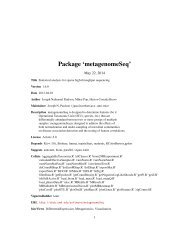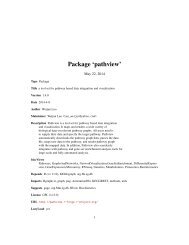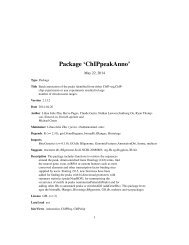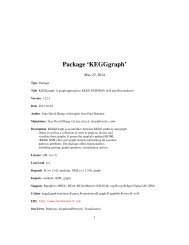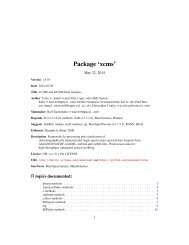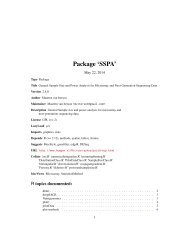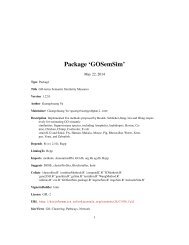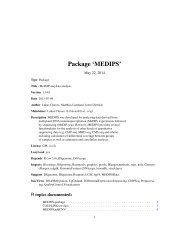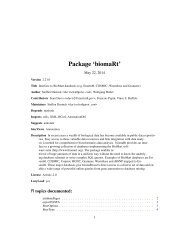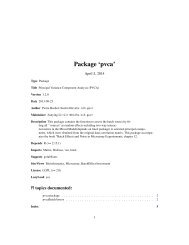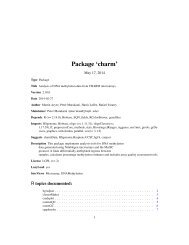Package 'limma' - Bioconductor
Package 'limma' - Bioconductor
Package 'limma' - Bioconductor
You also want an ePaper? Increase the reach of your titles
YUMPU automatically turns print PDFs into web optimized ePapers that Google loves.
18 arrayWeights<br />
Arguments<br />
object<br />
design<br />
weights<br />
method<br />
maxiter<br />
tol<br />
maxratio<br />
trace<br />
object of class numeric, matrix, MAList, marrayNorm, ExpressionSet or PLMset<br />
containing log-ratios or log-values of expression for a series of microarrays.<br />
the design matrix of the microarray experiment, with rows corresponding to<br />
arrays and columns to coefficients to be estimated. Defaults to the unit vector<br />
meaning that the arrays are treated as replicates.<br />
optional numeric matrix containing prior weights for each spot.<br />
character string specifying the estimating algorithm to be used. Choices are<br />
"genebygene" and "reml".<br />
maximum number of iterations allowed.<br />
convergence tolerance.<br />
maximum ratio between largest and smallest weights before iteration stops<br />
logical variable. If true then output diagnostic information at each iteration of<br />
the ’"reml"’ algorithm, or at every 1000th iteration of the ’"genebygene"’ algorithm.<br />
Details<br />
Value<br />
The relative reliability of each array is estimated by measuring how well the expression values for<br />
that array follow the linear model.<br />
The method is described in Ritchie et al (2006). A heteroscedastic model is fitted to the expression<br />
values for each gene by calling the function lm.wfit. The dispersion model is fitted to the squared<br />
residuals from the mean fit, and is set up to have array specific coefficients, which are updated in<br />
either full REML scoring iterations, or using an efficient gene-by-gene update algorithm. The final<br />
estimates of these array variances are converted to weights.<br />
The data object object is interpreted as for lmFit. In particular, the arguments design and<br />
weights will be extracted from the data object if available and do not normally need to be set<br />
explicitly in the call; if any of these are set in the call then they will over-ride the slots or components<br />
in the data object.<br />
arrayWeightsSimple is a fast version of arrayWeights with method="reml", no prior weights<br />
and no missing values.<br />
A vector of array weights.<br />
Author(s)<br />
Matthew Ritchie and Gordon Smyth<br />
References<br />
Ritchie, M. E., Diyagama, D., Neilson, van Laar, R., J., Dobrovic, A., Holloway, A., and Smyth, G.<br />
K. (2006). Empirical array quality weights in the analysis of microarray data. BMC Bioinformatics<br />
7, 261. http://www.biomedcentral.com/1471-2105/7/261/abstract



